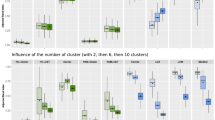Abstract
In this work, we present a new data mining (DM) approach (called tuned clustering analysis), which integrates clustering, and tuned clustering analysis. Usually, clusters which contain borderline results may be dismissed or ignored during the analysis stage. As a result, hidden insights that may be represented by these clusters, may not be revealed. This may harm the overall DM quality and especially, important hidden insights may be uncovered. Our new approach offers an iterative process which assist the data miner to make appropriate analysis decisions, and avoid dismissing possible insights. The idea is to apply an iterative DM process: clustering, analyzing, presenting new insights, or tuning and re-clustering those clusters which have borderline values. Clusters with borderline values are chosen and a new sub-database is built. Then, the sub-database is split, based on the attribute with the highest Entropy value. The tuning iterations, continues until new insights were found, or if the clusters quality are below a certain threshold. We demonstrated the tuned clustering analysis on real Echo heart measurements, using km-Impute clustering algorithm. During the implementation, initial clusters were produced. Although the quality of the clusters was high, no new medical insights were revealed. Therefore, we applied a clustering tuning and succeeded in finding new medical insights such as the influence of gender and the age on cardiac functioning and clinical modifications, with regard to resilience to diastolic disorder. Applying our approach has successfully managed to reveal new medical insights which were restored from borderline value clusters. This stands in contrast to traditional analysis methods, in which these potential insights may be missed or ignored.
Access this chapter
Tax calculation will be finalised at checkout
Purchases are for personal use only
Similar content being viewed by others
Change history
23 January 2019
The original version of this chapter contained an error in the third author’s name. The spelling of Chaim Yosefy’s name was incorrect in the header of the paper. The author name has been corrected.
References
Han, J., Pei, J., Kamber, M.: Data Mining: Concepts and Techniques. Elsevier, New York (2011)
Srinivas, K., Rani, B.K., Govrdhan, A.: Applications of data mining techniques in healthcare and prediction of heart attacks. Int. J. Comput. Sci. Eng. (IJCSE) 2(02), 250–255 (2010)
Ben Ishay, R., Herman, M.: A novel algorithm for the integration of the imputation of missing values and clustering. In: Perner, P. (ed.) MLDM 2015. LNCS (LNAI), vol. 9166, pp. 115–129. Springer, Cham (2015). https://doi.org/10.1007/978-3-319-21024-7_8
Bache, K., Lichman, M.: UCI Machine Learning Repository (2013). http://archive.ics.uci.edu/ml. Accessed 1 May 2013
Kremer, H., et al.: An effective evaluation measure for clustering on evolving data streams. In: Proceedings of the 17th ACM SIGKDD International Conference on Knowledge Discovery and Data Mining, pp. 868–876. ACM, San Diego (2011)
Na, Y., et al.: HS-measure: a hybrid clustering validity measure to interpret road traffic data. In: Proceedings of the 5th International ICST Conference on Performance Evaluation Methodologies and Tools, pp. 274–280. ICST (Institute for Computer Sciences, Social-Informatics and Telecommunications Engineering), Paris (2011)
Guo, A.: A new framework for clustering algorithm evaluation in the domain of functional genomics. In: Proceedings of the 2004 ACM Symposium on Applied Computing, pp. 143–146. ACM, Nicosia (2004)
Tsipouras, M.G., et al.: Automated diagnosis of coronary artery disease based on data mining and fuzzy modeling. IEEE Trans. Inf. Technol. Biomed. 12(4), 447–458 (2008)
Soni, J., et al.: Predictive data mining for medical diagnosis: an overview of heart disease prediction. Int. J. Comput. Appl. 17(8), 43–48 (2011)
Palaniappan, S., Awang, R.: Intelligent heart disease prediction system using data mining techniques. In: IEEE/ACS International Conference on Computer Systems and Applications, AICCSA 2008. IEEE (2008)
Bhatla, N., Jyoti, K.: An analysis of heart disease prediction using different data mining techniques. Int. J. Eng. 1(8), 1–4 (2012)
Anbarasi, M., Anupriya, E., Iyengar, N.: Enhanced prediction of heart disease with feature subset selection using genetic algorithm. Int. J. Eng. Sci. Technol. 2(10), 5370–5376 (2010)
Wosiak, A., Zakrzewska, D.: On integrating clustering and statistical analysis for supporting cardiovascular disease diagnosis. In: 2015 Federated Conference on Computer Science and Information Systems (FedCSIS). IEEE (2015)
Zhang, S., Zhang, C., Yang, Q.: Data preparation for data mining. Appl. Artif. Intell. 17(5–6), 375–381 (2003)
Chobanian, A.V., et al.: The seventh report of the joint national committee on prevention, detection, evaluation, and treatment of high blood pressure: the JNC 7 report. JAMA 289(19), 2560–2571 (2003)
Zhao, R., et al.: Influences of age, gender, and circadian rhythm on deceleration capacity in subjects without evident heart diseases. Ann. Noninvasive Electrocardiol. 20(2), 158–166 (2015)
Adams, K.F., et al.: Relation between gender, etiology and survival in patients with symptomatic heart failure. J. Am. Coll. Cardiol. 28(7), 1781–1788 (1996)
Leinwand, L.A.: Gender is a potent modifier of the cardiovascular system. J. Clin. Invest. 112(3), 302–307 (2003)
Karavidas, A., et al.: Aging and the cardiovascular system. Hell. J. Cardiol. 51(5), 421–427 (2010)
Mirkin, B.: Clustering For Data Mining: A Data Recovery Approach (Chapman & Hall/CRC Computer Science). Chapman & Hall/CRC (2005)
Gandrud, C.: Reproducible research with R and R studio. Chapman and Hall/CRC (2016)
RStudio: An open source statistical language (2017). https://www.rstudio.com
Author information
Authors and Affiliations
Corresponding author
Editor information
Editors and Affiliations
Rights and permissions
Copyright information
© 2018 Springer International Publishing AG, part of Springer Nature
About this paper
Cite this paper
Ben Ishay, R., Herman, M., Yosefy, C. (2018). A New Approach for Tuned Clustering Analysis. In: Perner, P. (eds) Machine Learning and Data Mining in Pattern Recognition. MLDM 2018. Lecture Notes in Computer Science(), vol 10934. Springer, Cham. https://doi.org/10.1007/978-3-319-96136-1_34
Download citation
DOI: https://doi.org/10.1007/978-3-319-96136-1_34
Published:
Publisher Name: Springer, Cham
Print ISBN: 978-3-319-96135-4
Online ISBN: 978-3-319-96136-1
eBook Packages: Computer ScienceComputer Science (R0)




